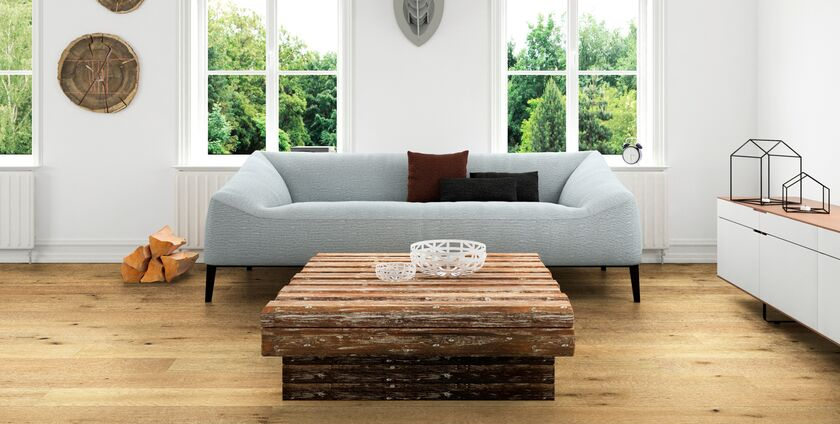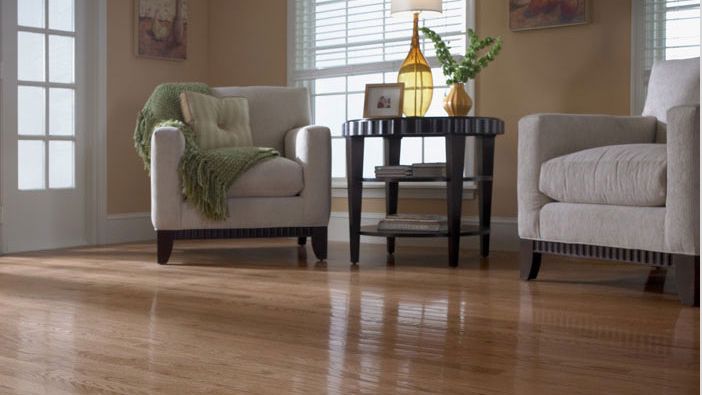How to Pick the Right Kind of Hardwood Flooring
Each week, Mansion Global tackles a topic with an elite group of designers from around the world who work on luxury properties. This week we look at how to choose the right wood flooring for you.
Wood is always a chic material for your floor. Something of a chameleon, it has the power to transform a space depending on the color and finish. “Wood floors add warmth, texture, and sophistication to a space, and can also set a tone or attitude,” said Nancy J. Ruddy, co-founder and executive director of interior design at architecture and design firm CetraRuddy
There’s a refinement to the look and feel that’s unparalleled. “They add an elegance and warmth in a way no other material can. It’s an understated richness like a fine cashmere sweater,” said New York-based interior designer Ryan Korban.
Consider the Space Itself
“First identify what type of mood you want to create in your environment. I tend to lean in one of two ways: either super light gray for a very soft feel or black for a sexy atmosphere. My favorite floors, which I recently did at 40 Bleecker, are cerused oak in a cashmere color by Listone. You can never go wrong with this, especially when done in a chevron pattern.
Less is More
“Wood floors spontaneously reconnect to nature. Keep the look as natural as possible and let the wood express itself. For a recent project at Greenwich West in New York City, I chose wide plank European white oak floors to complement the warm color palette of the finishes, such as Carrara marble countertops. Each are natural materials.

Hardwood Flooring Buying Guide
Hardwood Construction
Hardwood floors can be installed on any level of your home over different subfloors since they’re available in multiple constructions to mitigate moisture (see chart). It’s important to take moisture into consideration when you’re installing hardwood floors since changes in moisture can create issues, such as warping and gapping. To lessen the effects of moisture, keep moisture levels within manufacturer recommendations, and choose the right construction of hardwood flooring and installation materials. For an added layer of protection against moisture damage, install a moisture barrier.
3/4-Inch Solid
This is a 3/4-inch-thick solid piece of hardwood floor and what you might typically think of for hardwood floors. Because solid floors expand more when exposed to moisture than engineered floors, you can only install them over a plywood subfloor at or above ground level. If you have a crawl space, it’s a good idea to put a moisture barrier underneath it to help control moisture coming through the ground into your home.
5/16-Inch Solid
This is a thinner version of the 3/4-inch hardwood floor. Since it’s solid, you can’t install it in the basement or on concrete below ground level, but it’s thin enough to glue down to concrete at ground level or install over plywood at or above ground level. Urethane adhesives are required and moisture barriers are recommended for gluing down 5/16-inch solids. Most solid floors can be sanded and refinished. Check the manufacturer’s warranty.
Engineered Hardwood
Engineered floors are designed for installation over concrete and to help mitigate potential moisture issues. The cross-layer construction prevents the floor from expanding as much as a 3/4-inch or 5/16-inch solid floor when exposed to moisture. Therefore, you can install engineered anywhere in the home, including the basement. Engineered floors are also more environmentally friendly and less expensive than solid floors because the veneer is only a few millimeters thick instead of 3/4-inch thick. The real hardwood veneer of engineered floors differs from laminate, which has a printed paper veneer. Some engineered floors can be sanded and refinished. Check the manufacturer’s warranty.
Waterproof Hardwood
Waterproof hardwood flooring employs hardwood and bamboo veneers as well as a waterproof core and a proprietary protective coating. This flooring option resists moisture but still presents the same texture and grain patterns of traditional hardwood, making it a perfect choice for those who’re concerned about spills but still want genuine hardwood.

THIS IS HOW TO CHOOSE THE BEST HARDWOOD FLOORING FOR ANY HOME
So, you’re thinking about retiring your old floors, or you’re moving into a new space, and you’re interested in a natural, easy-to-maintain flooring choice. Of course, hardwood is an excellent pick for many people — it’s easier to clean than carpets and is known to stand the test of time. But, there are so many available options that finding the best hardwood flooring can be overwhelming.
How to determine the best hardwood flooring for your home:
First, understand the pros and cons of hardwood floors.
Next, examine your lifestyle.
Then, set a realistic budget.
After that, explore various hardwood types and species.
Once you know the rest, research your finish options.
Finally, consult with an expert.
HARDWOOD IS DURABLE… AS LONG AS YOU DON’T OVEREXPOSE IT TO WATER.
While hardwood floors are durable and can withstand spills and stains with proper treatment, they are especially prone to water damage (kind of like the wicked witch of the west); this makes them a risky candidate for areas like your bathroom, kitchen, and entryways. Installing hardwood in rooms where they are exposed to liquid will lead to damage.
IT IS EASY TO REFINISH, BUT NOT SO EASY TO INSTALL.
Most people will tell you it is easy to refinish hardwood floors, as long as you can stay off of them for a few days. Even so, it is difficult to install them, even for experienced DIYers. So, in the beginning, be prepared to hire a professional for the installation. At the very least, consider
IT IS CONSIDERED A WISE INVESTMENT.
The homeowners’ paradigm is that hardwood flooring will increase the value of your property. Most homebuyer’s jump at the idea of purchasing a home with hardwood floors — in many cases, even when carpet covers the original wood flooring. So, in the long run, the initial investment is probably worthwhile.

HOW TO CHOOSE THE BEST HARDWOOD FLOORING SPECIES FOR YOUR HOME
Gone are the days when selecting hardwoods for your home meant a slim offering of narrow planked solid oak hardwood flooring in a light tan color. Today, there are countless types of hardwood floors to satisfy everyone’s needs for wood species, color, style, performance and budget. While having many choices is always a good thing, it can also seem overwhelming, especially if you are new to the hardwood flooring world. That’s why LIFECORE thought it would be helpful to provide a way to drill down into those options, so you can ultimately choose the BEST flooring and species for you
First a note of definition and what we mean by species. Hardwood flooring is available in many types of wood. From Oak to Hickory and Maple to Acacia; each species has its’ own unique characteristics and performance attributes. Prioritizing your visual preference, as well as lifestyle and budget requirements, will help you determine which of the different wood species is right for your home. Engineered wood flooring is manufactured in many different species and with the addition of today’s high-performance finishes, those species now have the ability to perform very well for people with children and pets.
Where will the hardwood floors be going?
If you plan to install the flooring in a high traffic area such as a family room or hallway, consider the hardwood flooring species that have a higher Janka hardness rating. While exotic hardwoods tend to have the highest Janka ratings, many people steer clear of them not only because of the lack of sustainability but also because of their higher price and tendency to change color or fade over time. Fortunately, you can find the perfect alternative in several domestic and bountiful hardwood flooring species that will hold up well in high traffic areas. Oak is the standard at 1300, while Maple at 1450 and Hickory at 1820 are even harder.
Are you looking for the best flooring for dogs?
Let’s face it, most homes have pets, but many homeowners understandably forget to take them into consideration when choosing flooring. To have a home with hardwood and a dog or cat, there are tips for success, however, you can take it a step further by choosing a more rustic hardwood style and species that will keep your floors looking newer, longer. Hardwood flooring species which have knots and character marks, like LIFECORE’S Abella Acacia Luxe, will help to hide dents and scratches, and if an accident does happen, the color variations will help mask the remnants of a stain. It is also recommended that you refer back to the Janka scale to help select a hardwood flooring species like Maple or Hickory for longer wear
What is your décor style?
While most types of hardwood floor species will work in a variety of decors, selecting them in certain colors, plank widths or styles can truly define your personal style. Below are some examples of the best hardwood floor species, color, and style to suit your décor

How to Choose the Right Hardwood Floor Color
Installing new hardwood flooring is a major investment, which makes choosing the right one even more daunting, especially for a wood-floor newbie. Is oak better than walnut? What’s the deal with warm tones? Is a light floor a recipe for disaster? I went straight to the experts to find out what homeowners should know.
Start With the Basics
There are two basic factors that go into what hardwood floors looks like, says Patrick Bewley, vice president of marketing at California-based flooring brand Duchateau. First is the grain, which is determined primarily by the species of wood. Then there’s the finish or stain, which creates the color. “Our advice is to start by selecting the color range that is most attractive to you—the one that speaks to you and the space,” he explains. “Then, you can look at various grain patterns and surface treatments within that range and find the one that you feel works best with the selected color and your other design elements.”
Undertones Matter
Just like with paint colors, it’s crucial to consider the undertone of your flooring. Most designers warn against anything wood finishes that skew very red or orange, which have a tendency to look dated. But that doesn’t mean that you should steer completely clear of warm undertones. In fact, says Bewley, one of the biggest trends in wood flooring right now is a warm take on of-the-moment gray. “These new tones mix the coolness of gray with warmer undertones, creating high livability along with an on-trend look,” he notes.
Think About Upkeep
You might love the look of a certain type of wood flooring now, but think about how it’ll hold up—and how much effort you’re willing to put into keeping it pristine. As a rule of thumb, says Bewley, “harder woods, such as European Oak, are a good choice for high-traffic and kid-centric spaces, whereas softer species, such as walnut, are better suited for lower-traffic areas.”
Swatch Before You Stain Your Floors
Thinking about staining your existing floors? Just like with paint colors, you’ll want to apply swatches before you commit to one. What appears to be a light neutral on the chip in your local hardware store might end up looking totally different in your space, depending on everything from light to the wall color—and, of course, the wood itself. “The species and tone can impact the final appearance,” says Behr senior product manager Rick Bautista. “For example, if you’re using a traditional transparent or semi-transparent stain, a clear pine board stained with a chocolate color will appear different than a darker, redwood board stained with the same color.”